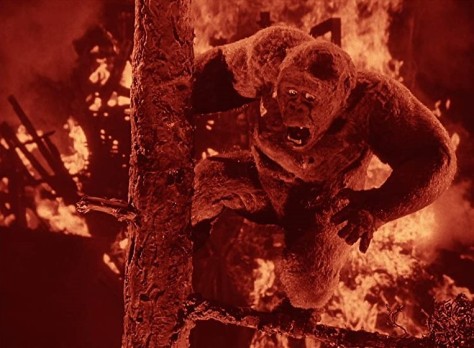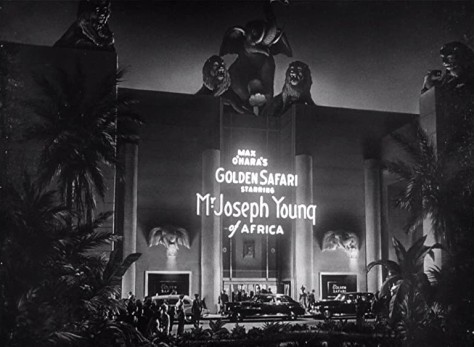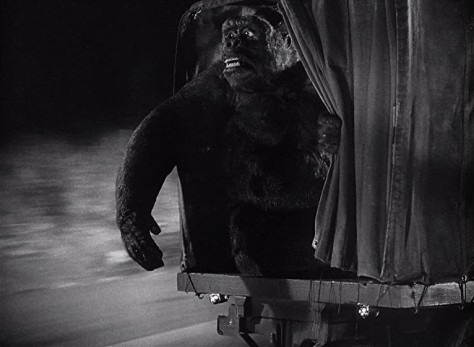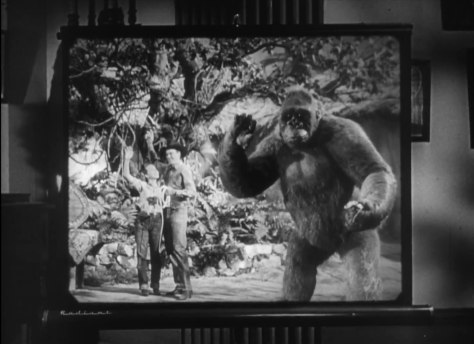
The profound cinema influence of King Kong rests not only in the fantasy it effectively brought to life, but in the tragedy at the core of its story, both conveyed in the mythic terms of early cinema. Yet one of the most interesting things about the creative minds behind Kong—producer Merian C. Cooper, director Ernest B. Schoedsack and his screenwriter wife Ruth Rose, and stop motion animator Willis O’Brien—is that they essentially remade their greatest creation twice, and in both cases tried to put a much more optimistic spin on the story. This started shockingly early with Son of Kong, released nine months (nine months!) after the original, and is a movie that I think has very interesting as a follow-up (I’ll probably write about it someday); it then came rolling back over a decade-and-half later with Mighty Joe Young, which saw the old gang working together one last time to unknowingly usher in the next decade of monster movies. This intentional softening of Kong‘s giant ape melodrama may in some ways seem like a commercial decision, to make it more kid-friendly (more kid-friendly than King Kong, a movie that fascinated children for decades), but the interpretation I’ve always preferred is that it’s the result of a deep guilt: they had created a resonant tale of humanity exploiting and destroying natural wonder and beauty, as represented by a beast both terrifying and sympathetic, and it’s terribly sad to think that such a thing could only ever be a tragic monster laying dead on the Manhattan concrete. Mighty Joe Young manages to capture many of those same themes, but in its deviations from the Kong template, it demonstrates that there is another way for it all to end.

The key way both this and Son of Kong differentiate themselves from their predecessor, and make their title creature seem less monstrous, is by altering the relationship between the large ape and the lead actress from a one-sided-infatuation to an equally platonic—or familial in Young’s case—love. The movie opens with eight-year-old Jill Young, daughter of a American running a farm in Tanganyika Territory, Africa (now Tanzania), trading money and various household items to two natives for whatever it is they are carrying around in a basket—which turns out to be a baby gorilla, which she names Joe (they do have footage of a real baby gorilla, but it’s clear that it was never in the same room as the actors.) Her father isn’t too terribly impressed to find this out, but he ultimately takes it in stride and despite telling Jill that one day she will not be able to look after Joe, we flash forward ten years and see that the two are still together, Jill now played by Terry Moore (still acting to this day!), and Joe now about twelve feet tall. No one seems to think it’s that odd that this gorilla is twice the size of a normal one.

Jill and Joe come in contact with the urban west thanks to Hollywood club owner Max O’Hara, who has a single-minded obsession with creating new stage show gimmicks and hires a bunch of cowboys to help him lasso lions for his current Africa-themed club. Further linking Mighty Joe Young and King Kong, O’Hara is played by Robert Armstrong, the original Carl Denham, and he is essentially playing a slightly friendlier and more broadly comedic version of that character in here (he yells “Yipe!” twice over the course of the movie.) After encountering Joe, who seems to have a particular grudge against lions, O’Hara becomes determined to get him for his act, convincing Jill that the money they’ll make will help her maintain her deceased father’s property. It probably also helps that she starts getting lovey-dovey with Gregg, one of the aforementioned cowboys (played by western actor and stuntman Ben Johnson) with a laid-back demeanour and friendly drawl.

As with its predecessor, there’s definitely a colonialist undercurrent to Mighty Joe Young—what with the unquestioned status quo of white people owning large tracts of African land and telling the locals what to do all the time—but I guess it’s progress that the Africans are just treated like people and not necessarily as hyper-exoticized Others, albeit people without defined personalities who mostly act as the hired help. Jill and a few others even speak Swahili, although I could not tell you if it is accurate Swahili. On the other hand, when we finally see O’Hara’s Africa club and stage show, it’s hyper-exoticism in a way that feels bordering on parody, which does fit O’Hara’s preference for the gaudy.

Unlike all those jokes about Denham’s “show” in King Kong, Joe actually has a few genuine acts at O’Hara’s club, backed by a full orchestra and Jill on piano playing “Beautiful Dreamer”, Joe’s favourite song/ This eventually includes an amusing tug-of-war with a group of stereotypical strongmen (including real life boxer/wrestler Primo Carnera), who are all introduced individually beforehand. Not surprisingly, this turns out to be a hit show, with billboards (which credit Joe as “Mr. Joseph Young of Africa”) loudly proclaiming when it has hit its tenth and then seventeenth week. Despite the success, Jill becomes increasingly concerned about the well-being of Joe (and herself) while they’re so far away from home, which probably isn’t helped by the increasingly degrading performances we see them partake in, especially one where she’s dressed as a organ grinder with Joe as the monkey while the crowd throws giant coins at him. While Kong’s disastrous dalliance with show business is seen in more general terms, this really gets into how the whole thing wears down the animal and its caretaker, which is reinforced by the movie’s portrayal of the forties socialites attending the show as shallow and obnoxious, ending with the group of drunks who give Joe alcohol and then antagonize him, leading to a club-demolishing rampage. The ape is never the problem—it’s the people around him.

Although the story’s sympathy for the animals (except lions apparently, as many are rather brutally killed in that rampage scene) and condemnation of human indifference to their plight is very obvious, I have seen it argued that this movie is less effective than Kong because the ape at the centre is by all definitions tame, even if he has to warm up to any person other than Jill. That’s true to a certain extent, but one the ways it balances that out is in the way Joe is portrayed through stop motion animation: he has a very emotive, sympathetic face, but is portrayed in a more natural way that allows him a certain wild animal edge even when he gets moments of “acting”, such as whenhe gets drunk. It probably helped that Joe is an exaggerated version of a real gorilla rather than a gigantic, fantastical ape monster like Kong, which gave them more real life references they could use. As well, making Joe both more realistic (and a more manageable size) likely makes the movie’s happier ending a lot easier to justify.

While his name is front and centre, it should be noted that Willis O’Brien was too busy as an overseer to do the actual animation himself, so he left that job to his assistants Marcel Delgado (the model constructor for this and Kong), Pete Peterson (who would go on to assist O’Brien on The Black Scorpion and The Giant Behemoth), and one Ray Harryhausen. Many of the techniques that Harryhausen would build upon in his own subsequent movies are seen here (a scene of the cowboys trying to lasso Joe is an early run for the similar moments in Valley of Gwangi), including many that evolved from O’Brien’s work, and for its time there are some sequences involving the puppet interacting with actors and sets that are impressively complex. Just like in Kong, the effects and the life they give to their central beast are crucial to getting us to engage with it, and Mighty Joe Young deservedly won the Academy Award for effects that year.

Following the club incident, the movie segues into what is one of the premier tropes of the “befriending a wild animal” genre: authority figures declare that Joe is dangerous and must be destroyed, leading to Jill, Gregg, and O’Hara staging a jailbreak and truck chase with police as they try to get Joe on a boat back to Africa. This is where the wildest swerve from King Kong takes place, where the tragic instead becomes something rousing and heartwarming The climactic sequence finds our protagonists stopping to help out at a burning orphanage, where the film’s black-and-white film suddenly becomes tinted a fiery red for atmosphere. Ultimately, Joe also helps out, using all his ape prowess to rescue a trapped orphan while the building rather spectacularly crumbles around them. So, it’s not enough that Joe, unlike Kong, gets to go home, but he gets to go home a hero beloved by all—a sentimental Hollywood happy ending, but one that feels sort of deserved, if not for everything that came before it in the actual movie, but in our knowledge of the less happy endings for other giant movie apes.

The ending of the movie shows O’Hara, still putting on gaudy overproduced club acts (his latest is some kind of underwater unspectacular), receiving a film reel from Jill and Gregg, now happily together in Africa alongside Joe (for us in the audience, the final onscreen text says “Good bye from Joe Young.”) If you want to read a little more into this conclusion, you could interpret this as saying that the medium of film allows us to see and experience the wonders of the natural world without having to remove them from where they belong and propping them up on a stage, a lesson that would also carry more weight by your knowledge of King Kong. There is, in fact, a way for people to live harmoniously with other animals.

Mighty Joe Young was not a big success when it released, although that certainly didn’t do anything to hinder the career of its lead animator—Harryhausen never did anything else giant ape related, but I imagine that getting to work on an ape movie with the godfather of the category was probably enough for one lifetime. The subsequent generations who embraced King Kong did, however, embraced this one all the same when they saw it on TV, which is probably why it was remade in 1998 with Charlize Theron in the lead and effects by Rick Baker, who was (and, I would argue, still is) the leading expert on gorilla special effects. Maybe there was just a desire for more stop motion ape action, but I also like to believe that they could recognize this as the more lighthearted, whimsical counterpoint to the tragedy of Kong and the horror of so many other monster movies, a movie where the monster gets a chance at redemption. It is good to see a happy gorilla every once in a while.

REVIEW ALL MONSTERS will return on January 1st!
